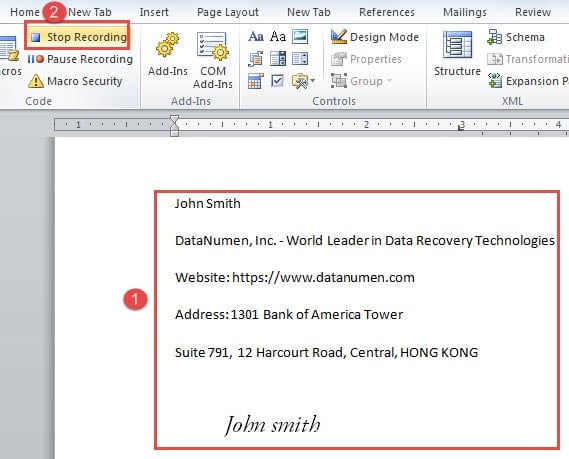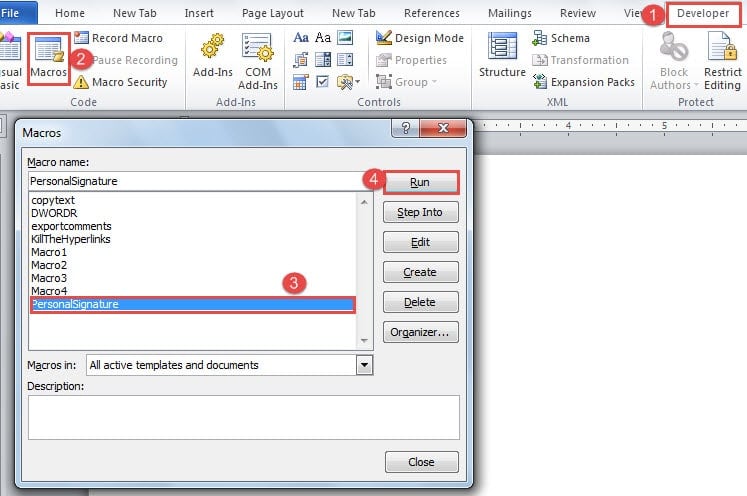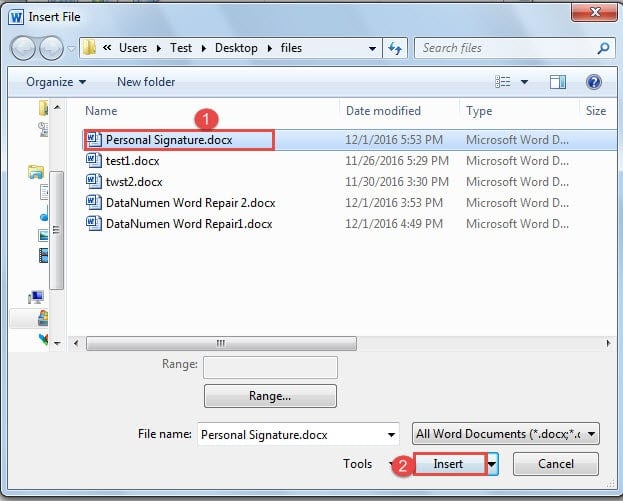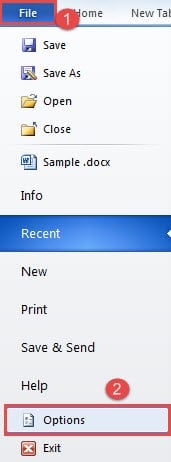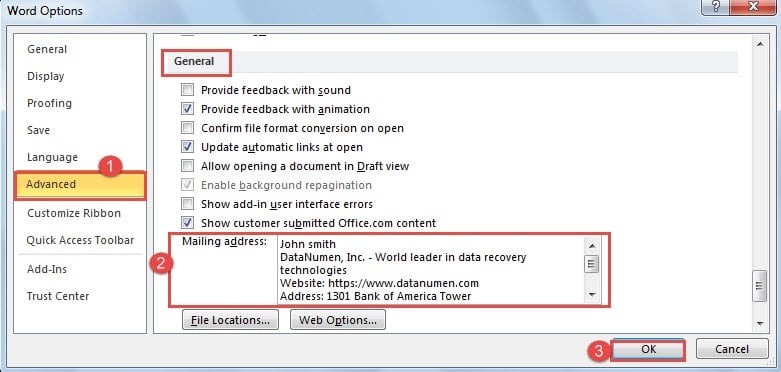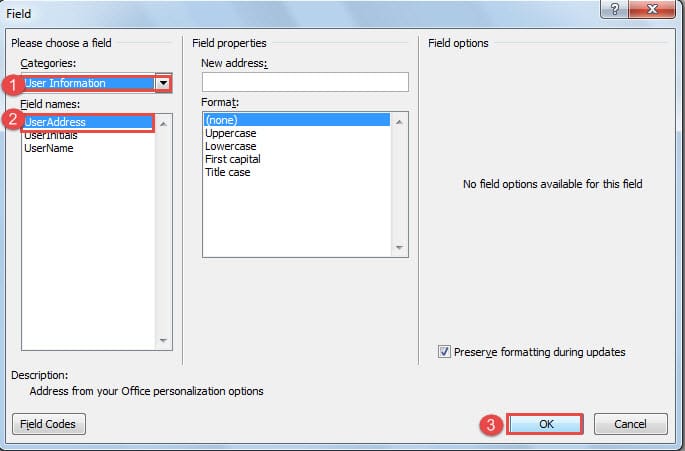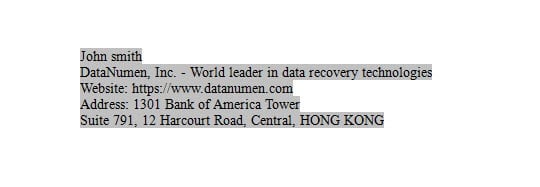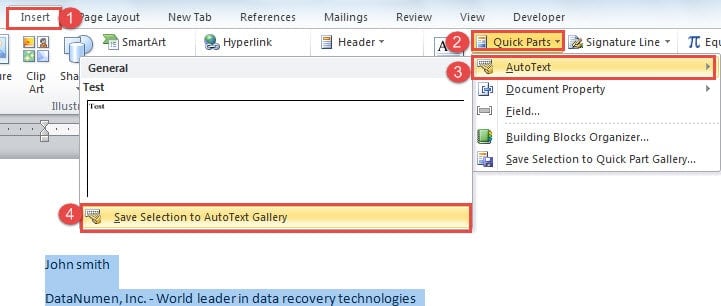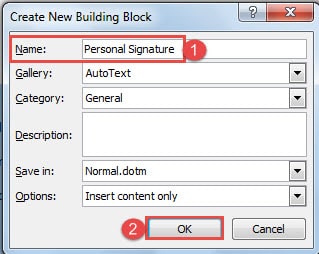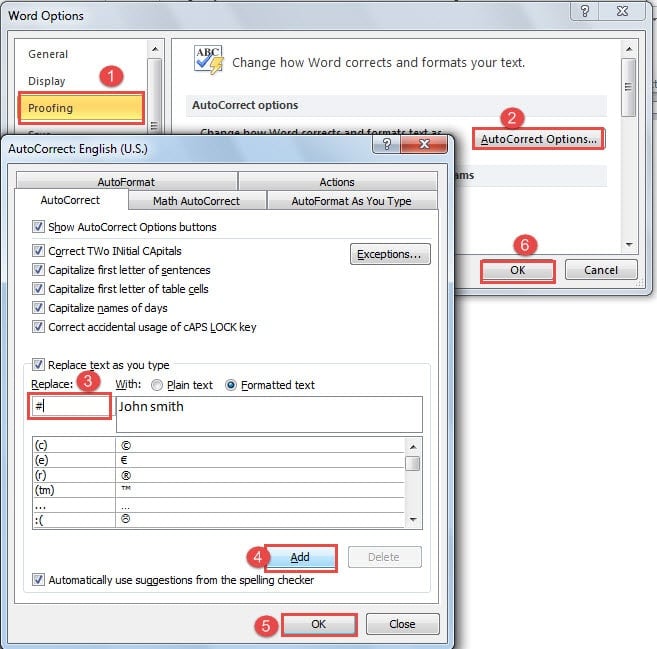In today’s article, we offer you 6 varying quick methods to insert personal signature to your Word document.
Now and then, when work on a Word document, it’s quite often that we will need to insert our personal signature into the file. For example, it can include name, phone number, and address and so on, which can enable people to contact us. Yet, to input these texts every time manually can be tiresome and time-consuming. So you must go through the following ways to learn to work efficiently.
Method 1: Use a Macro
You can record a macro first then run it later when you need to get the same texts. Here are details:
- Firstly, make sure “Developer” tab is added to your Ribbon. For detailed steps, you can refer to this article: How to Insert Background Music into Your Word Document
- Next, place cursor at the position where your personal signature goes.
- Then click “Developer” tab.
- Then click “Record Macro” in “Code” group.
- Next the “Record Macro” dialog box will pop up. So type in “Macro name” text box.
- Then choose “All Documents” in “Store macro in” list box. By the way, you can assign macro to button or keyboard. For specific instructions, please visit: How to Remove the Formatting of Pasted Texts with Macro and VBA in Your Word
- Next click “OK” to start record the macro.
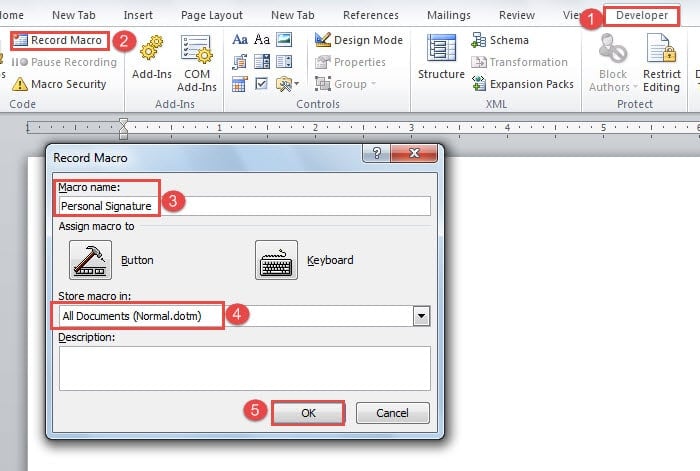
- Now you enter your signature information on your document. And you can insert a signature image.
- Next, click “Stop Recording” under “Developer” tab.
- Next time when you need to use the same texts, just click “Developer”.
- Then go to “Macros”.
- Next choose the right macro name.
- Lastly, click “Run” and you shall get the exact texts and image you input when record the macro. Certainly, if you have assigned the macro to button or keyboard in step 6, you can start running the macro by clicking button or pressing keyboard in step 10 directly.
Method 2: Insert a Text
- To begin with, open a new Word document. And enter your signature text there and save the file.
- Next time when you need it, place your cursor properly first.
- Then click “Insert” tab.
- And click the upside-down triangle button on “Object”.
- Next choose “Text from File”.
- Now in “Insert File” windows, find and click the file which stores your personal signature.
- Then click “Insert” button, and you will have the full personal signature inserted on your Word document.
Method 3: Use a Field
- At first, click “File” tab.
- Then click “Options” to open “Word Options” dialog box.
- Next click “Advanced’ option.
- And under “General” page, input your personal signature in “Mailing address” text box.
- And click “OK” to save the change.
- Later when you need the texts, just click “Insert” tab first.
- Then click “Quick Parts” in “Text” group.
- And choose “Field” on the list-menu.
- Now in “Field” dialog box, choose “Use Information” for “Categories”.
- Then choose “User Address” field name.
- Lastly, click “OK”.
The text you get will be in field code, and when you click it, it will show the grey shading. Meanwhile, you can only get a de-formatting text without signature image.
Method 4: Choose from Auto Text Gallery
- Firstly, enter your texts on a document and select it.
- Secondly, click “Insert” tab.
- Then click “Quick Parts”.
- Next choose “Auto Text”.
- And click “Save Selection to Auto Text Gallery”.
- Now the “Create New Building Block” dialog box will pop up. Just name the text.
- Then click “OK”.
- When you have to use the text, simply repeat step 2, 3, 4.
- Then choose “Personal Information” block.
Method 5: Use Auto Correct Options
- Firstly, type personal signature including a signature image in a new document and select it.
- Then click “File”.
- Then click “Options”.
- And in “Word Options” dialog box, click “Proofing” first.
- Then click “AutoCorrect Options” button.
- Now in “AutoCorrect” dialog box, you can see the personal signature is in the “With” text box. Type a symbol in “Replace” text box. For instance, here we will type “#”.
- Then click “Add”.
- And click “OK”.
- Finally remember to click “OK” in “Word Options” dialog box, too.
- Now next time you can get the same text along with a signature image simply by typing the symbol. And press “Backspace”, you will get the symbol only.
Method 6: Create a Digital Signature
Besides all the above methods, there is the sixth one. Actually, a digital signature can also provide you some information. There is our previous article for you to visit: 2 Methods to Add Digital Signature to Your Word Document
Comparison of 6 Methods
| Methods | Advantages | Disadvantages |
| Method 1: Use a Macro | 1. Can add whatever information and set its format the first time you save it.
2. Can insert a signature image. 3. Can easily modify the inserted signature. 4. No need to save an additional file. |
1. More steps comparatively
2. You have to type the text When you record the macro. 3. Cannot protect file integrity. |
| Method 2: Insert a Text | 1. Fewer steps comparatively.
2. Can add whatever information and set its format the first time you save it. 3. No need to type to get the text at the first time. 4. Can insert a signature image. 5. Can easily modify the inserted signature.
|
1. You have to save an additional file.
2. Cannot protect file integrity. |
| Method 3: Use a Field | 1. No need to type to get the text at the first time.
2. Can easily modify the inserted signature. 3. No need to save an additional file.
|
1. More steps comparatively.
2. Cannot add formatted text. 3. Cannot insert a signature image. 4. Cannot protect file integrity. |
| Method 4: Choose from Auto Text Gallery | 1. Fewer steps comparatively.
2. Can add whatever information and set its format the first time you save it. 3. No need to type to get the text at the first time. 4. Can insert a signature image. 5. Can easily modify the inserted signature. 6. No need to save an additional file. |
Cannot protect file integrity. |
| Method 5: Use Auto Correct Options | 1. Fewer steps comparatively.
2. Can add whatever information and set its format the first time you save it. 3. No need to type to get the text at the first time. 4. Can insert a signature image. 5. Can easily modify the inserted signature. 6. No need to save an additional file. |
1. Cannot protect file integrity.
2. You will have to occupy a symbol to represent the signature. |
| Method 6: Create a Digital Signature | 1. Can add many kinds of information.
2. Can insert a signature image. 3. No need to save an additional file. 4. Can protect file integrity.
|
1. More steps comparatively.
2. Cannot add formatted text. 3. Not easy to change the inserted signature. |
Better be Prepared for Word Corruption
To sum up, you’ve understood Word has so many functions. Yet, as computer software, it shares some of the common shortcomings. And one of them is prone to errors, which more or less leads to file damage. Therefore, you have to get a tool to repair corrupt Word file beforehand.
Author Introduction:
Vera Chen is a data recovery expert in DataNumen, Inc., which is the world leader in data recovery technologies, including xls error repair tool and pdf repair software products. For more information visit www.datanumen.com
